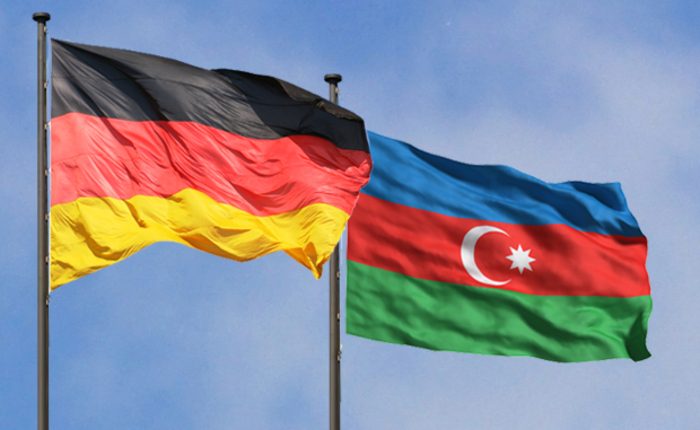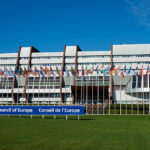Especially popular they were in the Württemberg region of Germany. In 1817, members of the sect began to migrate to the territory of the Russian Empire to spread their ideas (Velitsyn, 1893, p. 24).
The first contacts between Azerbaijanis and Germans date back to the beginning of the 19th century. By the decree of the Committee of Ministers of the Russian Empire dated September 7, 1818, a total of 2,000 Germans were to be resettled from Württemberg to the South Caucasus. Most of them settled in Yelizavetpol (Ganja) and Gazakh uyezds of Yelizavetpol (Ganja) Governorate, as well as in Tiflis and Borchaly uyezds of Tiflis Governorate (Diesendorf, 2006, p. 173).
Members of the German community in Azerbaijan
The colonies/villages founded by Germans in Azerbaijan are as follows.
Annenfeld (Annino) was founded in 1818 by 67 German families from Württemberg and named after Grand Duchess Anna Pavlovna. It was destroyed in 1826 during the Russo-Persian wars as a result of attacks by the Persian and local Azerbaijani population (referred to as Russians Tatars as the time). Dramatically reduced by fever (185 people were born and 479 died here in 1818-1831), the population was relocated to other colonies in 1831, but returned in 1836 because of the lack of land. The village was moved 8 versts north in 1873. In 1909, a German church was built here. Until 1917, it was part of Yelizavetpol (Ganja) uyezd of Yelizavetpol (Ganja) Governorate, and part of Shamkhor District during the Azerbaijan SSR. The village is currently located in the territory of Shamkir District of the Republic of Azerbaijan. 3,890 dessiatins of land belonged to Germans here, and the population was mainly engaged in winemaking and gardening. Soglasiye (“Concord”) winery was established in 1905, and a distillery was opened in 1907. After the establishment of the Soviet government, a high school, cooperatives and a collective farm named after Clara Zetkin began to operate here. In 1935, the Soviet government deported 600 Germans from the colonies of Annenfeld and Yelenendorf to Karelia for “espionage.” After the German invasion of the USSR and the outbreak of the Great Patriotic War, the remaining German residents of the colony were deported to Kazakhstan on October 15-20, 1941. Population: 277 (1818), 185 (1836), 183 (1843), 193 (1859), 199 (1869), 492 (437 Germans) (1886), 860 (665 Germans) (1897), 751 (1907), 780 (1913), 875 (1918), 956 (1921), 1,189 (969 Germans) (1923), 2,166 (1,208 Germans) (1926) (Diesendorf, 2006, p. 35).
Annenfeld village union (Amtsbezirk Annenfeld) – This village union in Yelizavetpol (Ganja) Governorate included the villages of Annenfeld and Eigenfeld. 800 people lived in it in 1907, and 976 Germans lived in it in 1914 (Diesendorf, 2006, p. 35).
Helenendorf, or Yelenino (after 1938 Khanlar) was founded in 1819 by 118 German families from Württemberg and named after Grand Duchess Yelena Pavlovna. This village was part of Yelizavetpol (Ganja) uyezd of Yelizavetpol (Ganja) Governorate until 1917, and part of Khanlar (Narimanov/Helenendorf) District during the period of the Azerbaijan SSR. The village is currently located in the territory of Goygol city of Goygol Disctrict of the Republic of Azerbaijan. It was destroyed in 1826 and part of the population was enslaved. In 1819-21, 88 people were born and 214 died here, and in 1829-30, these figures were 60 and 126, respectively. In 1855, a German church was built in the village. In 1913, 6,695 dessiatins of land in this village belonged to the tsar, and 4,200 dessiatins belonged to the Germans. The Germans were mainly engaged in winemaking, horticulture, animal husbandry and cheese production. There were numerous various workshops, 12 ceramic factories and 10 fruit juice factories operating in the village. The main source of income was winemaking and wine trade. Vohrers’ and Hummes’ companies were leaders in this field. The Vohrers opened the first brewery in the South Caucasus here in 1868, and a mineral water plant in 1886. The Germans also conducted geological survey, and in 1898 the Vohrers discovered an iron deposit in Dashkasan and a gold deposit in Annenfeld. Founded in 1903, the Yardim Association established a winery and a brandy distillery in 1905. The Eintracht Wine Association and the Concordia Association (which became a cooperative after 1920) were established in 1905 and in 1908, respectively. Two hydroelectric power plants, 8 water mills, Vohrers’ electric mill and a water pipeline were installed. In 1908, a slaughterhouse was opened here. There were also a military hospital, a pharmacy and an anti-plague facility. The first school was opened in 1823, and a trade school in 1907 (a gymnasium after 1917). In 1917, Russian citizens of German descent were able to obtain permission to open their own technical school here. The German Society was founded in 1893; it built sports, reading, and listening facilities for men. There was also a youth society. In 1913, the German Women’s Literary Society was founded. After the establishment of the Soviet government, German farms here became cooperatives. During the Soviet era, a kindergarten was opened here, and a secondary school and clubs were opened in 1926. In 1924, a school for the deaf and a collective farm named after Ernst Telman were established as part of the Concordia Cooperative. In 1935, 600 Germans (including the Annenfeld Germans) were deported to Karelia for “espionage.” On October 20-25, 1941, the residents of the village were exiled to Pavlodarsk and Akmolinsk Oblasts. Population: 501 (1819), 745 (1836), 609 (1843), 792 (1859), 974 (1869), 1,626 (1,457 Germans) (1886), 2,572 (1,835 Germans) (1897), 3,525 (2,384 Germans) (1908), 2,157 (1919), 2,180 (1921), 3,310 (2,227 Germans) (1923), 3,985 (2,329 Germans) (1926), 2,675 (1941) (Diesendorf, 2006, p. 166).
Georgsfeld (Georgiyevskoe, after 1932 Leninfeld /Lenin) was founded in 1885 by 80 German families from the colony of Helenendorf and was named after Grand Duke George Alexandrovich. This village was part of Yelizavetpol (Ganja) uyezd of Yelizavetpol (Ganja) Governorate until 1917, and part of Shamkhor District during the period of the Azerbaijan SSR. This village is currently located in the territory of Chinarli township of Shamkir District of the Republic of Azerbaijan. 2,422 dessiatins of land there belonged to Germans, and the main occupations of the population were winemaking and gardening. A winery was established in the village in 1907, and a distillery was built in 1910. The Hoffnung/Nadezhda (“Hope”) winery was established in 1906, and in 1913, there were a slaughterhouse, a bakery and a tea house in the village. During the Soviet period (1926), a branch of the Concordia winery cooperative, a secondary school, a kindergarten, and a club were opened, and “Borba” (“Struggle”) collective farm and a hydroelectric power plant operated here. Population: 212 (1889), 596 (450 Germans) (1897), 637 (1903), 840 (1913), 811 (1918), 861 (1921), 936 (1928) (Diesendorf, 2006, p. 112).
Alekseyevka (Kirovka) was founded in 1904 by Germans from the colony of Helenendorf. Until 1917, this village was part of Gazakh uyezd of Yelizavetpol (Ganja) Governorate, and part of Agstafa/Gazakh District during period of the Azerbaijan SSR. This village is currently located in the territory of Agstafa District of the Republic of Azerbaijan. There were 350 dessiatins of land belonging to Germans, and the main occupation of the population was winemaking. During the Soviet era, the Concordia winery of the collective farm named after Lenin operated here, and a school and a kindergarten were opened. Population: 96 (1907), 260 (1913), 262 (1919), 365 (1921), 351 (1928) (Diesendorf, 2006, p. 25).
Eigenfeld (Petrovka, also Engelsfeld, Ermashly, Irmashly, Olginsky) was founded in 1906 by Germans from Helenendorf. This village was part of Yelizavetpol (Ganja) uyezd (Annenfeld village union) of Yelizavetpol (Ganja) Governorate until 1917, and part of Shamkhor District during the Azerbaijan SSR. This village is currently located in the territory of Shamkir District of the Republic of Azerbaijan. There were 615 dessiatins of land belonging to Germans (in 1868). The main occupation of the population was winemaking, and during the Soviet period there was a winery department of the Concordia collective farm here. Population: 49 (1907), 100 (1913), 196 (1928) (Diesendorf, 2006, p. 566).
Grünfeld (“Green field”) was founded in 1907 by Germans from the colony of Helenendorf. Until 1917, this village was part of Gazakh uyezd of Yelizavetpol (Ganja) Governorate, and part of Agstafa/Gazakh District during the period of the Azerbaijan SSR. The territory of the village is currently located in the village of Vurgun of Agstafa District of the Republic of Azerbaijan. 740 dessiatins of land belonged to Germans here. In 1909, the Mercury Association (which produced lemonade, wine and vodka) was established here, and during the Soviet period, the Rote Fane collective farm (the winemaking division of the Concordia collective farm) operated. During the Soviet era (1926), a kindergarten and a secondary school were opened in the village. Population: 340 people (1913), 468 (1921), 411 (1928) (Diesendorf, 2006, p. 139).
Grünfeld village union (Amtsbezirk Grünfeld) – This village union located in Gazakh uyezd of Yelizavetpol Governorate included the villages of Grünfeld and Yelizavetinka (Diesendorf, 2006, p. 139).
Traubenfeld (“Wine field”, later Tovuz) was founded in 1912 by Germans from the colonies of Elizavettal and Alexandersdorf. Until 1917, the village was part of Gazakh uyezd of Yelizavetpol (Ganja) Governorate, and part of Tovuz District during the period of the Azerbaijan SSR. The village is currently located in the Tovuz District of the Republic of Azerbaijan. 440 dessiatins of land belonged to Germans here. The main occupations of the population were winemaking and viticulture. In 1926, a school and a kindergarten were opened. During the Soviet era, the “Sovetstern” collective farm operated here. Population: 123 (1913), 306 (1921), 393 (1928) (Diesendorf, 2006, p. 490).
Yelizavetinka (Luxembourg, also Agstafa, Marksovka, Yelizavetovka, Yelizavetli) was founded in 1914 by Germans from the colony of Helenendorf. This village was part of Gazakh uyezd (Grünfeld village union) of Yelizavetpol (Ganja) Governorate until 1917, and part of Agstafa/Gazakh District in the Azerbaijan SSR. This village is currently located in Agstafa District of the Republic of Azerbaijan. During the Soviet era, the International collective farm operated here. Population: 50 (1918), 203 (1928) (Diesendorf, 2006, p. 168).
The total of 5,800 Germans lived in the South Caucasus in 1858 (0.1% of the total population). This figure increased to 9,354 people (0.2% of the total population) in 1886 and to 16,669 people (0.3% of the total population) in 1897. The number of Germans in Baku Governorate was 1,721 (0.2% of the total population) in 1886, 3,430 (0.4% of the total population) in 1897, and in Yelizavetpol (Ganja) Governorate in those years 1,902 (0.3% of the total population) and 3,194 (0.4% of the total population), respectively. The number of Germans in Azerbaijan during the Soviet period was: 13,149 (0.6% of the total population) in 1926, 23,133 (0.7% of the total population) in 1939, 22,841 in 1941, 1,492 (0.04% of the total population) in 1959, 1,361 (0.03% of the total population) in 1970, 1,048 (0.02% of the total population) in 1979, 748 (0.01% of the total population) in 1989. (Diesendorf, 2006, p. 173). These figures show how the number of Germans in the country decreased after World War II.
As we already know, the Germans who migrated to the Russian Empire were Stundists. Stundism as a religion can be considered the predecessor of Evangelical Protestantism. They can also be referred to as Baptists. After the Stunde Brotherhood settled in the governorates of the Russian Empire, they spread their religion among the local population. The population of the German colonies established in Azerbaijan was also Stundist. At first, they practiced their religion only among themselves. In 1855, as mentioned earlier, the first German church—St. Johanniskirche (St. John’s Church)—was founded in Helenendorf. Later, German Lutheran churches were built in Gadabay in 1868, in Shamakhi in 1869, in Yelizavetpol (Ganja) in 1885, and in Annenfeld in 1909. In 1896-1899, Erlöserkirche (Church of the Savior), popularly known as simply Kirche, was built in Baku. The first Baptist church in Baku was founded in 1880 by former Molokan V.V. Ivanov. After the persecution of the Germans during the Soviet era, Kirche has been functioning as a music/organ hall since 1936.

The main population group in Azerbaijan where the Baptists spread their influence was the Russian Molokan community. For example, although the father of Vasily Ivanov-Klyshnikov, who founded the village of Novo-Ivanovka in the Yelizavetpol Governorate in 1852, tried to raise him in the Molokan religious tradition, in 1866 (at the age of 20), people he met during a trip to Baku caused him to change his religious views, to “go in search of truth,” until finally, at the age of 25, he decided to become a Baptist. He founded the second largest Russian Baptist society in all of the Russian Empire in Novo-Ivanovka, supervised the construction of a number of churches, worked at the illegal Beseda (Bethesda) magazine from 1890, and at the official Baptist magazine from 1907 and was the editor-in-chief of the latter in 1913-1914. While living in Baku from 1900 to 1917, Ivanov served as the presbyter in the Baptist Church, which he founded in 1880, spreading his faith. Ivanov left the country shortly after the establishment of the Azerbaijan Democratic Republic. He died in 1919 (Kovalenko, 2006, pp. 57-59).
In the 1930s, German communities were subjected to repressions, and in 1941, along with the general deportation of Germans, the operation of German/Lutheran churches was suspended. In general, during the Soviet era, German religious denominations existed in Azerbaijan in three forms: Baptists, Adventists and Pentecostals. There were Baptist churches in Kirovabad (Ganja), Sumgayit, Khachmaz, Jalilabad, Lankaran, Shamakhi, Vartashen (now Oguz), Gadabay, Fizuli and Nefchala districts. Starting from 1961, Baptists in the country were forced into clandestine activities. The first group of Adventists appeared in Baku in 1884, but they had to leave the city due to persecutions. In 1906, an Adventist missionary arrived in Karyagino (now Fuzuli) and began to spread his faith there. Another Adventist society was founded in Shamkir, in the village of Kura. In the following years, the community was persecuted and went underground. The community of Pentecostals was founded as a result of the activities of missionaries from Vyborg in Baku during World War I. During the Soviet era, they operated in secret. After the end of the Soviet era and the restoration of Azerbaijan’s independence, Azerbaijani Baptists established the Evangelical Christian Union in 1992. In 1993, the Greater Grace Free Evangelical church appeared in Baku. The church is a member of the Greater Grace World Outreach Protestant movement. The members of the church used the Kirche building for worship. Following the 2009 Law on Freedom of Religious Beliefs in Azerbaijan, the Greater Grace Church was banned from conducting religious activities in the Kirche from 2012 as part of the persecution of unregistered religious organizations. According to a 2010 report by the Pew Research Center, there are 20,000 Protestants in Azerbaijan.
The role of Germans in the Azerbaijani economy
The Germans were among the first investors in Azerbaijan. German investors came here when the Azerbaijani lands were still part of the Russian Empire. They made an especially great contribution to the development of winemaking here. It was through the efforts, diligence and the operation of the companies established by the Vohrer brothers and the Hummel brothers that Azerbaijan was able to become the winemaking center of the South Caucasus (Jafarli, 2003, p. 10).
In 1854, during the Russo-Ottoman War, the need for telegraph communication arose. Therefore, the Siemens company, founded by the German brothers Walter and Werner von Siemens, was engaged in the construction of a telegraph line in the Caucasus. In 1863, the Siemens brothers first invested in the copper deposits of Gadabay and began operating in Azerbaijan. Until the early 20th century, the company extracted two-thirds of all copper from the Caucasus. In his memoirs, Werner von Siemens notes that the Gadabay copper deposits date back to ancient times, even BC. After that, the first German consulate was opened in Gadabay. The consul was William Bolton, who was also the German ambassador to Tbilissi (Dornfeldt, 2015, p. 42). Although he wrote a letter to the center expressing his desire to be relieved of his post as consul in Gadabay, as he had to stay in Tbilisi (Georgia) as ambassador, his request was granted 15 years later and no consular appointments were made since. In 1879, the Nobel brothers, who were of German origin, entered the oil sector of Azerbaijan and established the Nafta (Oil) Production Association. During this period, Germany supplied 20% of its oil needs from Azerbaijan’s oil reserves: a facility was set up in Bavaria to process oil transported from Baku. After his visit to Baku in 1886, the German ambassador to Iran wrote a letter to the German emperor, noting that German investment in railway construction and other sectors in the region could yield successful results (Dornfeldt, 2015, p. 44).

However, Azerbaijan’s oil wealth also caused some problems. The Russian Empire did not want to leave Baku and Azerbaijan out of its sphere of influence, while other great powers, especially the German Empire, wanted to establish their own influence here during World War I. In 1918, the British magazine Near East published an article with the following headline: “Baku is the largest oil center in the world. If oil is the queen, Baku is her throne.” (Tokarzhevsky, 1957, p. 34). During this period, the Nobel brothers were the largest shareholders in the oil industry of Azerbaijan. The Nobel brothers wanted to sell oil to all parties of the war. However, this plan could not work at a time when there was an urgent need for oil, which had a great impact on the outcome of the war. On the contrary, the company’s goods could be confiscated by the Russian Empire. On the other hand, the Ottoman Empire also joined the war and stopped oil supplies via the Baku-Batumi road. This led to a surge in oil prices during the period.
In 1911-1913, the price of Baku oil rose from 21.7 kopecks to 44.1 kopecks. But the Bolshevik revolution disrupted all plans, the Russian Empire collapsed, and everything that belonged to foreign companies was nationalized, effectively putting an end to the activities of the Germans in the oil industry of Azerbaijan. Meanwhile, the price of oil rose to 70 kopecks (Gökçe, 2014, p. 941). The Ottomans, Germany’s allies in the war, entered Azerbaijan in 1918. But before that, the Germans had not been sure that the Turks could enter Baku. That was why the German consul in Istanbul wrote the following letter. “If we can reach an agreement with the Bolsheviks, Baku oil can pass into our hands fully and safely. But if we go to war with the Bolsheviks, they will be forced to burn the deposits, and neither we nor the Turks will be able to use the oil fields.” The idea that Baku would be burned in case of any emergency was mentioned in Shaumyan’s letter to Lenin dated June 23, 1918. Thus, on August 27, 1918, the Treaty of Brest-Litovsk was signed between the Germans and the Bolsheviks. According to the secret clause of this treaty, the Germans had to prevent the Ottomans from entering Baku, and instead got to own some of Baku’s oil (Abutalibov, 2008, p. 72). However, realizing that they could not hinder the progress of the Turks, the Baku Commune decided to invite the British to protect the city from the Bolsheviks. Germany, in its turn, renounced the previous agreement and decided to help save Baku. General Hindenburg said that he was sending two German troops to the South Caucasus for the Ottoman government to liberate Baku from the British. However, before the arrival of the Germans, the Ottoman army entered Baku on September 15, 1918 (Kadyshev, 1960, p. 76).
A day later, the ADR moved the capital from Ganja to Baku. During the period of the Azerbaijan Democratic Republic between 1918 and 1920, foreign companies, including German ones, were able to continue their activities in Azerbaijan unimpeded. During the ADR period, Azerbaijani Germans were represented by one member in the country’s parliament—Lorenz Jacob Kun from Helenendorf. One of Kun’s main goals was to protect the interests of the German colonies in Azerbaijan, especially those of entrepreneurs. An event dedicated to the 100th anniversary of the establishment of the Helenendorf colony was held with official permission on June 9, 1919. Under the leadership of Wilhelm Gur, one of the shareholders of the Hummel Brothers Union, and with the participation of many German businessmen, the Allemaniya Kavkazika youth organization was founded in 1918 in Helenendorf. After the signing of the military alliance agreement between Georgia and Azerbaijan against foreign (Bolshevik) occupation in June 1919, there was a unit/regiment consisting of representatives of German colonies in the armed forces. Christian G. Hummel from Helenendorf played a special part in recruiting Germans for this regiment (Jafarli, 2003, pp. 12-13). With the seizure of power in Azerbaijan by the Bolsheviks, the unimpeded economic activity of the Germans in the country stopped until 1991.
German investment in Azerbaijan in modern times
The economic relations between Azerbaijan and Germany are at their highest today. Germany is one of the countries with which Azerbaijan has the largest trade turnover. Thus, Germany is one of the five largest exporters to Azerbaijan, as well as one of the main importers of Azerbaijani oil and gas products. According to the report of the State Statistics Committee, 2014 was the year with the largest trade turnover between the two countries. In the same year, Azerbaijan imported goods worth $703.6 million from Germany and exported goods worth $1.9 billion to Germany, the trade turnover between the two countries totaling $2.6 billion. In subsequent years, this figure decreased, according to the latest data for 2019, when Azerbaijan’s export to Germany was $931.8 million and import from Germany $710.4 million, the trade turnover between the two countries being $1.6 billion. For comparison, after Azerbaijan gained independence and was officially recognized by Germany (the diplomatic relations between the two countries were established in February 1992), the trade relations between the two countries in 1992 were at a much lower level. Thus, in 1992, Azerbaijan exported only $12.9 million worth of goods to Germany and imported only $9.6 million worth of goods from Germany. That is, in 1992, the trade turnover between the two countries reached only $22.5 million. As can be seen, during the years of independence (1992-2019), the trade turnover between the two countries increased by more than 70 times.
The German-Azerbaijani Chamber of Commerce, established in 2012, works to promote trade and economic ties between the two countries. However, interestingly, the Germans do not have a share in the oil and gas industry of Azerbaijan. Thus, when the “Contract of the Century” was signed on September 20, 1994 with the participation of British and American companies, German companies were not among them, which was mentioned later with regret in Frankfurter Rundschau, Der Spiegel, and other German press. After the official visits of the German Foreign Minister Klaus Kinkel and the then Economic Cooperation Minister Karl Spranger to Baku in 1995, in January 1997, the German company Deminex (now Wintershall) started research and development in the oil sector of Azerbaijan, in particular in the Lankaran-Deniz and Talysh-Deniz oil and gas fields, with a 30% share. As a result of this visit, Germany also allocated 5 million Deutschemarks for assistance to the Azerbaijani refugees, 1.8 million marks for democratic reforms, and 13 million marks for the implementation of joint German-Azerbaijani projects (Zeynalova, 2008, p. 34).
The German-Azerbaijani Business Association (DAWF), established in 1998, serves to increase economic cooperation between the two countries. Thus, in the following years, other German companies entered the country’s oil and gas sector. However, German participation in oil and gas production in Azerbaijan is largely focused on the production, safety and maintenance of pipelines. For example, according to the agreement signed between the German company Oil and Gas ProServis and SOCAR, since 2005 the maintenance of pipelines within Azerbaijan’s oil and gas projects is given to the Germans. According to the agreement, the share distribution is set at 25% Siemens, 45.1% Target Petroleum, 29.9% SOCAR. Regular meetings, conferences and economic forums play an important role in expanding the Azerbaijani-German economic relations. In general, the Germans like to establish communication that will serve mutually beneficial cooperation. Mutual meetings, business forums and economic cooperation conferences held in and after 2005 have borne fruit and served to increase economic cooperation between the two countries. The German-Azerbaijani economic conference in Berlin in 2005 was organized by the DAWF. Thus, after such measures, large-scale (multi-million) projects came to the fore, in particular, the flow of German investment in the non-oil sector of Azerbaijan increased. For example, the volume of German investment in Azerbaijan was $1.2 million in 1995, $2.1 million in 2004, and surged to $21.5 million a year later, in 2005 (Zeynalova, 2008, p. 45).
The German view on the Nagorno-Karabakh issue
The communication between Azerbaijanis and Germans began in the early 19th century, and although it has reached its peak today (as Azerbaijan is Germany’s largest trading partner in the South Caucasus), we cannot say with certainty that the Germans have a pro-Azerbaijani view on Nagorno-Karabakh. For example, a joint project of EuroCaucAsia and Humboldt University collected and analyzed articles on Nagorno-Karabakh published in a number of German newspapers and magazines from 1988 to 2008 (Auch, 2015, 5). The results of this analysis make it clear the Germans attach importance to the “right of Armenians to unite with their homeland”, see the conflict as a religious confrontation, have no information on the events leading up 1988 (the mass expulsion of Azerbaijanis from Armenia, Armenian provocations in mutual massacres, etc.), on the Armenian occupation of the regions around Nagorno-Karabakh (those regions not having been inhabited by Armenians). I believe that increasing communication with the Germans in this area, the comprehensive, truthful coverage of the events and historical facts in newspapers and magazines can be useful in this matter as well.
During the Second Karabakh War, the German media were more neutral and voiced the arguments of both sides. Even the uncertain statement of the official representative of the German Federal Foreign Office on the status of Nagorno-Karabakh (it being part of Azerbaijan) proves this. The fact that Germany remains neutral while a number of European countries are pro-Armenian can be assessed as positive. But this is not success. This may be due to the lack of significant difference in the number of Armenians and Azerbaijanis living in Germany today. Besides, unlike other European countries, the Armenian Diaspora in Germany was formed later, in the 20th century (after the events of 1915). That is, unlike France, England and other European countries, the Armenian national committees did not have a deep-rooted (dating back to the 19th century) activity in Germany. However, the Sumgayit-Baku events of 1988-1990 were widely reported in the German media. In fact, the weak Azerbaijani-German relations in the early 1990s and the more efficient efforts by the Armenian lobby also played their part in giving these events the “Armenian face” in Germany and the emergence of antipathy towards Azerbaijanis in Germany. Even though Sumgayit and Ludwigshaven were declared sister cities in 1986, the inter-city relations cooled two years later. This relationship was re-established at the beginning of the 21st century, when a partnership agreement on the development of cooperation was signed in 2002, German aid for Sumgayit Children’s Hospital and other social projects were implemented. Other sister cities in Germany and Azerbaijan are Baku and Mainz (1984). However, the events that took place after the collapse of the Soviet Union and the establishment of the Republic of Azerbaijan, especially in its first years, resulted in the suspension of this “sisterhood”. Mayor of Mainz Jens Beutel told APA that the undemocratic events of Ayaz Mutallibov’s years (most likely involving the treatment of Armenians) had caused the disruption in the cooperation between the cities. Currently, work is underway to resume the process. Such “sisterhoods” not being just words and further enriching their essence with real actions can be useful for the development of relations between the two countries and peoples. For this, we need to increase effective communication with the Germans. This communication can cover the NGO sector, economic projects and political cooperation, and finally active measures related to Karabakh. Given the Germans’ willingness to invest, especially in the non-oil sector, the involvement of German companies in Karabakh’s infrastructure projects, and then establishment of “sisterhood” between a city in Karabakh and a German city (for example, between Dresden, bombed in World War II, and Agdam, one of our cities that have suffered the most destruction in the conflict, or between the capital of Württemberg Stuttgart and Goygol, etc.), relevant active promotion and lobbying can play a critical role. Thus, the true realities of Nagorno-Karabakh will be better understood in German society and a warm attitude towards Azerbaijan/Azerbaijanis will be created.
References:
Абуталыбов, Р. (2008). Азербайджанская Демократическая Республика: сборник статей, посвященных 90-летию Первой республики. Москва: Salam Press. [Abutalibov, R. (2008). The Azerbaijan Democratic Republic: a collection of articles devoted to the 90th anniversary of the First Republic]
Auch, E.M., Yıldırım, H. A. (2015). The Karabakh Conflict in Selected German Media, 1988-2008: A research paper, Berlin: Humboldt University.
Дизендорф, В.Ф. (2006). Немцы России: Населенные пункты и места поселения. Энциклопедический словарь, Москва: ЕРН. [Diesendorf, V.F. (2006). Germans of Russia: Localities and places of settlement. Encyclopedic Dictionary]
Dornfeldt, M., Seewald, E. (2015). Geschichte Der Deutsch-Aserbaidschanischen Beziehungen, Frühjahr, 1(10). [Dornfeldt, M., Seewald, E. (2015). History of German-Azerbaijani Relations]
Джафарли, М. (2003). Политический террор и судьбы азербайджанских немцев, 2-е издание, Баку. [Jafarli M. Political terror and the fate of Azerbaijani Germans]
Gökçe, M. (2014). Birinci Dünya Savaşı Döneminde Hazar Petrolleri İçin Yaşanan Rekabet, İstanbul: Türk Dünyası Araştırmaları Vakfı Yayınları. [Gökçe, M. (2014). Competition for Caspian Oil in the World War I Period]
Кадышев, А. (1960). Интервенция и гражданская война в Закавказье, Москва: Воениздат. [Kadyshev, A. (1960). Intervention and Civil War in Transcaucasia]
Коваленко, Л. (2006). Облако свидетелей христовых (72 биографии с фотографиями), Киев: Центр христианского сотрудничества [Kovalenko, L. (2006). Cloud of Christ’s Witnesses (72 biographies with photographs)]
Токаржевский, Е.А. (1957). Из истории иностранной интервенции и гражданской войны в Азербайджане, Баку: Академия наук Азербайджанской ССР. [Tokarzhevsky, E.A. (1957). From the history of foreign intervention and civil war in Azerbaijan]
Велицын, А.А. (1893). Немцы в России: Очерки исторического развития и настоящего положения немецких колоний на Юге и Востоке России, СПб: Изд. «Русский вестник». [Velitsyn, A.A. (1893). The Germans in Russia: Essays on the historical development and the present situation of the German colonies in the South and East of Russia]
Зейналова, С. (2008). Азербайджано-германские отношения в контексте интеграции Азербайджана в Европейское сообщество, Баку: Mütərcim. [Zeynalova, S. (2008). Azerbaijani-German relations in the context of Azerbaijan’s integration into the European Community]
AzeMedia










